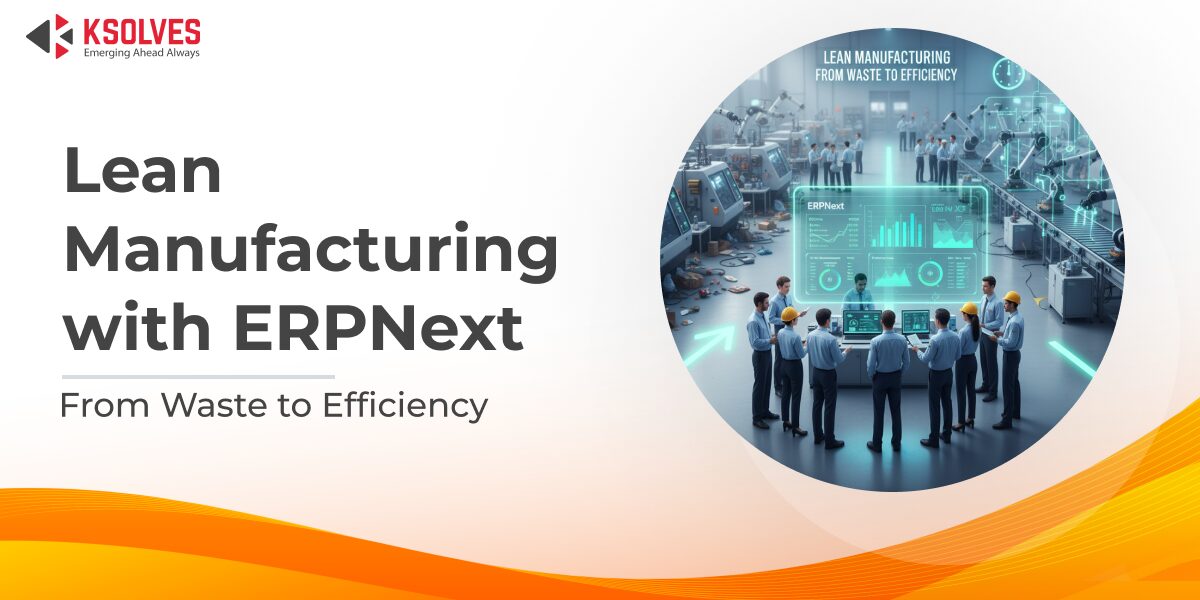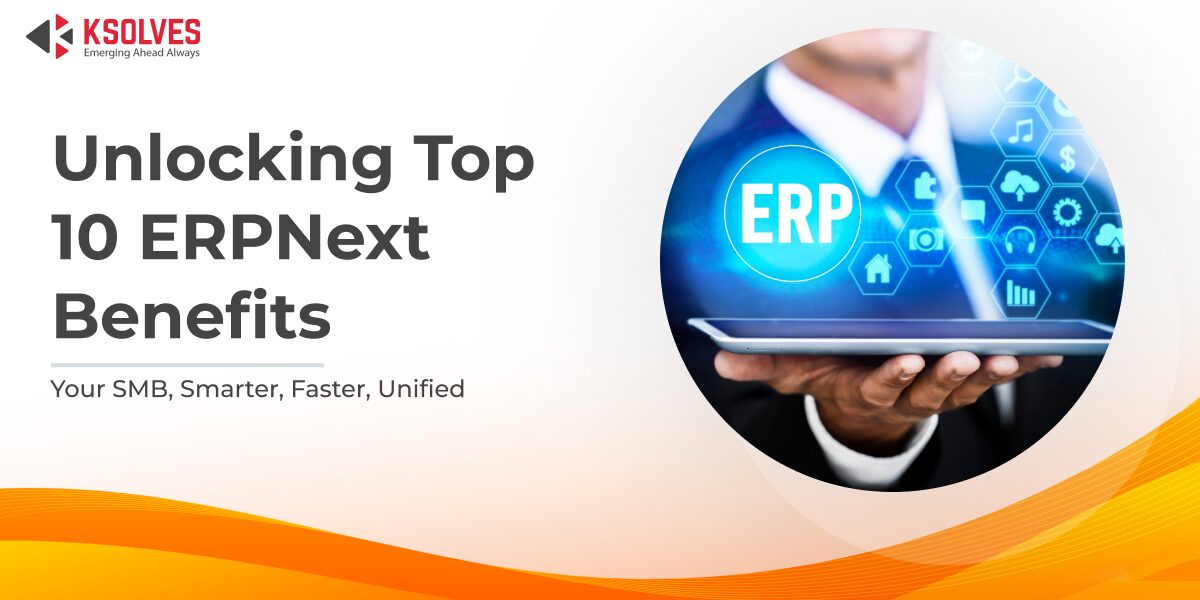ERPNext for Lean Manufacturing: Reducing Waste, Increasing Efficiency
ERPNext
5 MIN READ
November 3, 2025
![]()

Lean manufacturing is more than just a methodology – it’s a mindset focused on eliminating waste (muda), improving flow, and driving continuous improvement (kaizen). For manufacturers competing in today’s global market, lean practices translate into lower costs, shorter lead times, and faster responsiveness to customer demand.
But lean isn’t just about philosophy; it needs the right systems and data to be sustainable. This is where ERPNext, an open-source ERP platform, becomes a game-changer. With its integrated manufacturing modules, ERPNext provides the visibility, control, and automation required to scale lean practices effectively.
In this article, we’ll explore how ERPNext supports lean manufacturing, the strategies for successful implementation, and the KPIs to track along the way.
ERPNext’s Manufacturing Capabilities
ERPNext delivers a robust set of manufacturing features that serve as the backbone for lean-driven operations. Each module is designed to integrate seamlessly and provide the visibility, control, and flexibility required on the shop floor:
- Bill of Materials (BOMs, including multi-level BOMs)
Define raw materials, sub-assemblies, and operations across multiple levels for precise planning and costing.
- Work & Production Orders
Create and track work orders directly from sales or production plans, complete with material reservations, workflow management, and status updates.
- Material Requirement Planning (MRP)
Automates demand forecasting and material planning, ensuring purchase and production activities happen just in time, avoiding overstock and shortages.
- Inventory & Warehouse Management
Maintain real-time visibility into raw materials, work-in-progress (WIP), and finished goods, with advanced tools like batch/serial tracking, put-away rules, and pick lists to optimize movement.
- Workstations, Operations & Job Cards
Define machines and work centers, establish routing, and track execution at the operation level through job cards for accurate scheduling and capacity planning.
- Quality Control
Integrate quality inspections at key manufacturing stages to reduce defects, rework, and ensure compliance with standards.
- Workflow Automation
Configure approvals, notifications, and role-based permissions to streamline processes and minimize delays.
- End-to-End Traceability
Achieve a single source of truth by connecting sales, procurement, inventory, and production data into one unified system.
- Customizability & Flexibility
Built on the Frappe framework, ERPNext allows no-code customization, API integrations, and tailored workflows without compromising future scalability.
Together, these capabilities give manufacturers the structure and transparency needed to implement lean principles effectively, enabling smarter planning, smoother execution, and continuous improvement.
Lean Principles & How ERPNext Supports Them
Lean manufacturing is built on eliminating waste and continuously improving processes. ERPNext, with its integrated manufacturing modules, directly supports these principles by embedding lean thinking into everyday workflows. Let’s explore how ERPNext helps address each type of waste and reinforces lean practices.
1. Eliminate Overproduction & Excess Inventory
Overproduction often leads to tied-up capital, storage costs, and waste. ERPNext minimizes this risk through:
- Production Planning + MRP: Material Requirement Planning (MRP) and production plans ensure raw materials and finished goods are procured or manufactured just in time to meet demand.
- Projected Quantity: ERPNext’s “Projected Quantity” feature calculates current and future inventory needs based on sales orders, forecasts, and stock levels, helping avoid overstocking.
The result: leaner inventories, lower carrying costs, and improved cash flow.
2. Minimize Waiting & Delays
Delays often occur when approvals or communication bottlenecks stall production. ERPNext addresses this by:
- Automated Workflows: Approvals for purchase requests, production orders, or material transfers can be streamlined with defined workflows.
- Notifications & Triggers: Automated alerts ensure that pending tasks don’t sit idle, keeping processes moving smoothly.
This automation shortens lead times and helps maintain continuous flow on the shop floor.
3. Reduce Defects & Rework
Quality issues not only waste materials but also disrupt customer satisfaction. ERPNext provides:
- Quality Control Module: Inspections and checks can be embedded into production steps, ensuring defects are caught early.
- Batch & Serial Traceability: Each product is tracked from raw material to finished goods, making it easier to trace defects back to their source.
- Supplier Quality Metrics: Capture and analyze supplier performance to prevent recurring quality issues at the source.
Together, these tools help prevent defects and reduce costly rework.
4. Optimize Transportation & Movement
Unnecessary movement of materials or products wastes time and labor. ERPNext helps optimize by:
- Smart Warehouse Management: Stock entry, put-away rules, and pick lists reduce needless transportation within facilities.
- Batch & Serial Tracking: Prevents misplaced or misallocated items that require repeated movement.
This reduces non-value-added motion and enhances warehouse efficiency.
5. Minimize Excess Inventory & Motion
Excess WIP or finished goods often hide inefficiencies. ERPNext offers:
- Real-Time Inventory Visibility: Track what is in stock, where it is located, and why it was moved, ensuring that motion adds value rather than waste.
- Lean Planning Tools: Prevents over-buffering by aligning procurement and production closely with actual demand.
The outcome is a leaner supply chain with better flow and fewer hidden inefficiencies.
6. Drive Continuous Improvement (Kaizen)
Lean thrives on feedback and iteration. ERPNext enables Kaizen through:
- Dashboards & Reports: Monitor KPIs such as cycle time, scrap rate, and throughput for data-driven improvement.
- Traceability for Root-Cause Analysis: Use detailed transaction and movement records to identify bottlenecks and failures.
- Collaboration Tools: Workflows and audit trails encourage team input and accountability, making continuous improvement part of daily operations.
By embedding visibility and accountability into processes, ERPNext fosters a culture of ongoing refinement.
Key Metrics to Track
Measuring the impact of lean initiatives is just as important as implementing them. ERPNext makes this easier by providing real-time data and reports across the entire manufacturing cycle. Some of the most valuable KPIs to monitor include:
- Inventory Turns & Days Inventory Outstanding (DIO): Track how efficiently inventory is moving and how long capital is tied up in stock.
- Cycle Time & Lead Time (Order-to-Delivery): Measure how quickly customer orders are fulfilled from initiation to completion.
- On-Time Delivery Rate: Gauge how reliably you meet customer commitments.
- Scrap & Defect Rates: Identify quality issues early and monitor the effectiveness of corrective actions.
- WIP Inventory Levels: Ensure work-in-progress stays lean and does not mask inefficiencies.
- Throughput per Resource or Work Cell: Evaluate how effectively labor and equipment are being utilized.
- Supplier Reliability (On-Time Delivery & Defect %): Assess supplier performance and its impact on your production flow.
- Overall Equipment Effectiveness (OEE): Track availability, performance, and quality to measure true equipment productivity.
- Planned vs. Actual Cost/Time per Job: Monitor deviations between estimated and real performance to improve planning accuracy.
By tracking these KPIs within ERPNext, manufacturers gain a clear, data-driven view of progress. More importantly, these insights create the foundation for continuous improvement, helping you refine processes, reduce waste, and strengthen customer satisfaction over time.
Challenges to Anticipate
Adopting lean practices with ERPNext can deliver significant benefits, but it also comes with real-world hurdles. Being aware of these challenges upfront helps organizations plan effective mitigations:
- Resistance to Change: Teams may be hesitant to move away from spreadsheets or manual methods.
- Data Discipline Gaps: Missed scans, skipped entries, or incomplete logs can erode the accuracy of insights.
- Upfront Setup Effort: Accurate BOMs, routings, and workflows require significant initial investment.
- Balancing Lean with Variability: Supply chain delays, sudden demand shifts, or equipment breakdowns can disrupt lean flows.
- Over-Customization Risks: Tailoring ERPNext too heavily may complicate future upgrades and scalability.
- Advanced Planning Needs: Extremely complex scheduling and demand-driven planning may go beyond ERPNext’s native capabilities.
How Ksolves Can Help
At Ksolves, a leading ERPnext development company, we offer end-to-end consulting services, designed to help manufacturers:
- Manage change effectively: We provide structured training and change management support to drive user adoption.
- Enforce data discipline: With custom workflows, automation, and validation rules, we ensure data integrity on the shop floor.
- Streamline setup: Our experts configure BOMs, routings, and master data accurately, reducing costly errors later.
- Build resilient lean processes: We help design ERPNext workflows that accommodate real-world variability without breaking lean principles.
- Balance customization & scalability: By leveraging ERPNext’s built-in flexibility smartly, we enable lean-friendly processes while keeping the system upgrade-friendly.
- Extend capabilities: Where advanced planning or analytics are needed, we develop custom apps or integrate with specialized tools.
By partnering with Ksolves, manufacturers can overcome these challenges, transforming ERPNext into a true enabler of lean manufacturing success.
Conclusion
ERPNext equips manufacturers with the tools to make lean a reality: multi-level BOMs, integrated MRP, job tracking, quality checks, and real-time visibility. When combined with lean culture and disciplined execution, it can significantly cut waste and boost efficiency.
The formula for success is simple: start small, track results, and improve continuously. With ERPNext as your backbone, lean manufacturing can shift from aspiration to execution.



AUTHOR
ERPNext
Share with